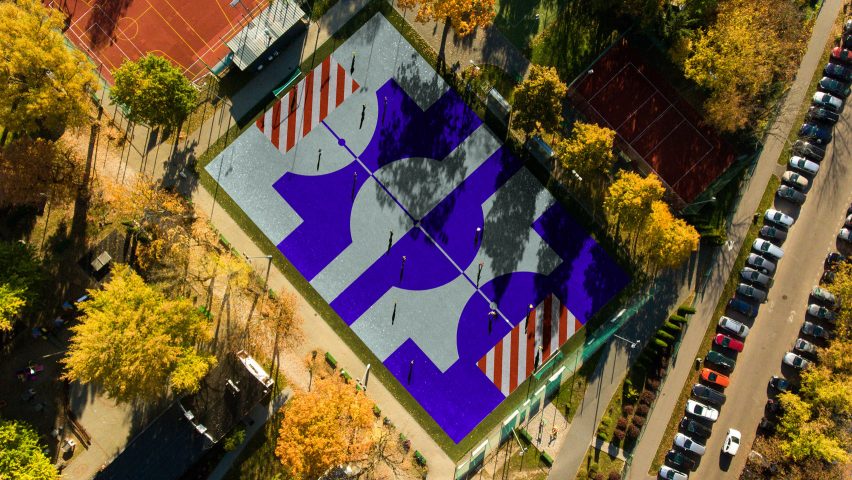Creative agencies from around the world have envisioned how public spaces could be adapted to allow social distancing as part of the Where We Stand initiative organised by editor David Michon.
In total 15 design teams created ideas to transform their favourite outdoor areas into safe and welcoming spaces that people can use while social distancing.
The designers tackled spaces in the UK, USA, Germany, Vietnam, Australia, Singapore and France with ideas including a "Keep Your Distance" football pitch, parabolic conversation mirrors and grassy picnic mounds.
London-based Michon, who was formerly the editor of Icon magazine and managing editor of Monocle magazine, instigated the Where We Stand project in partnership with agency Ask Us For Ideas after personally being impacted by the closure of public spaces due to coronavirus.
"When lockdown began, I realised just how crucial my local park was to me as a place to access open, green space," he told Dezeen.
"Yet, it was almost immediately bandaged up in caution tape. Public spaces are a lifeblood to many right now, and they deserve beauty and creativity – not pylons and haphazard spray paint."
Several of the projects focus on redesigning spaces in the English capital. East London-based Accept & Proceed's proposal focuses on reshaping amateur football pitches to allow for matches to restart.
It proposes placing colourful marking on the pitch highlight the area that each player can occupy so they do not come in contact with each other.
Brand consultancy Dn&co chose to focus its Augmented Assembly response on Parliament square, although like many of the ideas it is designed to be appropriate for many open spaces.
It proposes creating an app that would be used to project shifting patterns onto the ground so that spaces can be broken up organically, rather than using grids.
Other projects in London include a proposal by Mother Design to enliven the Victorian bandstand in Arnold Circus with colourful visuals, and Sthuthi Ramesh and Samar Maakaroun's proposal to adapt the water jets in Granary Square.
Another London-based agency, Lovers, has proposed creating a monument to the removal of a statue of slave trader Edward Colston in Bristol, which is similar to a memorial-design sketched by Banksy, to demonstrate the importance of spaces to gather.
Michon hopes that the varied designs will help inform hows public spaces are adapted as countries ease lockdown restrictions.
"The responses point to what we've been missing, and what public space can provide: either a place to be social and interact outside of these digital bubbles we've been stuck in, or to find space for pause and reflection," he said.
"I hope this project is in some small way a catalyst for people to think critically about 'what next' when it comes to these vital urban spaces."
The project asked designers to focus on a space they knew well. Outside of the UK, Foreign Policy proposed installing colourful speaker-receivers in Singapore's botanical gardens, while in Berlin Wkshps x Studio Pandan suggested installing a huge graphic that would read "we stand together" to define different spaces.
In Australia, DesignStudio proposed installing beach tents on Bondi Beach, in Vietnam, Rice suggested painting basketball courts in Ho Chi Minh City, and in Paris Wiedemann Lampe suggested installing interactive pillars outside the Centre Pompidou.
"We hoped for each participant to select a public space they had some connection to," said Michon. "These spaces and cities all have different personalities, histories, and value to their communities, which can be very layered, and so some engrained understanding of that was key."
Several agencies based in the USA also created proposals, with Hush designing benches for New York's Bryant Park and World's Greatest Internship alumni Es Youn, Kinzie Burke with Na Rojanusorn and Qiang Wang envisioning bright sculptures that would allow people to have conversations at longer distances in Brooklyn’s Domino Park.
In San Francisco, Manual suggested installing a simple series of grassy picnic mounds in an under-utilised area by the Ferry Building, while Nonymous proposed transforming Philadelphia park into a forum for discussion.
New York-based Character designed a stencil kit for an asterisk that would make any space appropriate for social distancing, something that Michon feels could easily be rolled out.
"Especially in countries, such as the UK and the US, where a Covid-19 response has been so poor, we're going to face restrictions in public spaces for some time," he said.
"So, I hope there's a real impact. I hope that some of these ideas become reality – some projects, of course, would be exceptionally easy to put into action, take for example Character's Asterisk Kit."
Numerous architects are considering how outdoor spaces can be adapted to the requirements of social distancing. In Italy, Caret Studio installed a gridded social-distancing system inside a piazza, while Paul Cocksedge designed social-distancing picnic blanket.
Austria-based studio Precht also designed the maze-like Parc de la Distance to encourage outdoor social distancing.

